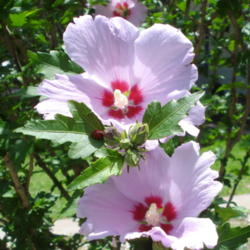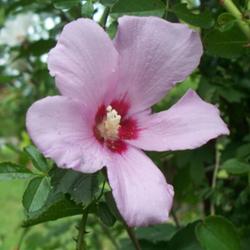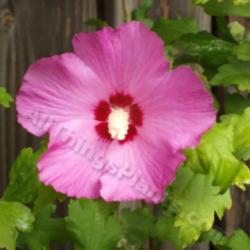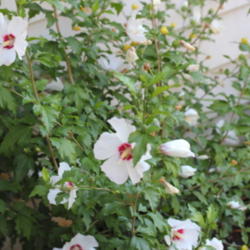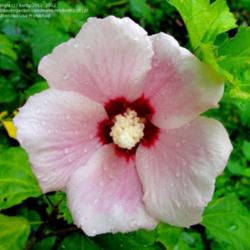A rose is a rose unless it's a Rose of Sharon, and then it's a hibiscus. Some say it's the name of a crocus and others swear it's the name of a tulip and then there's some confusion with the lily of the valley. Poor plant, most likely it lives in a state of constant identity crisis, never knowing on which side of the garden it should grow.
Those of us who live in the US know it as Hibiscus syriacus, but in other places the words 'Rose of Sharon' might refer to Tulipa montana, a bright red tulip-like flower that grows on the hills of Sharon in Israel or even to a kind of crocus that grows on the coastal plain of Sharon. And then again, in the book of Solomon in the King James version of the Bible, an ancient written reference was made to Lilium candidum as the Rose of Sharon.
Some of these earliest written references to a plant were early words of descriptive history and had passed through many translations before they were published by King James in 1611. Even Biblical scholars and historians can't agree on which plant the Rose of Sharon truly is in those early references. The location was probably correct. Sharon is a place. Actually, it is two places: the coastal region along the Mediterranean Sea on the Western edge of Israel and also the hilly plains pastureland located East of the Jordan River. What grows well there are crocuses and tulips, maybe a lily or two, but not our hibiscus.
Oh, but the confusion doesn't stop there, In the 1700s Linnaeus came along and gave the plant the Latin botanical name Hibiscus syriacus, thinking it was native to Syria, when in truth the Rose of Sharon as we know it today is native to East Asia. Are you confused yet? Will the real Rose of Sharon please stand?
The truth is, Rose of Sharon is a common name applied to several different blooming plants that are highly valued in different parts of the world. For us here in the States, that it is a simple blooming beauty hardly needs to be mentioned. Its beauty speaks for itself. It's a lovely, hardy, broadleaf ornamental shrub, vase shaped, with large showy flowers, that grows easily in zones 5 - 8. It blooms summer through fall on new growth, so it should be pruned in late Winter before the new growth starts.
It's also known in some places as Althea or Chinese hibiscus, two of the more common names. Its foliage is medium green, coarse and rather lacy, 3-lobed, and about 3 inches long. The large trumpet-shaped flowers are about 3 - 6 inches in diameter and are usually white, pink or lavender, or can also be deep tones of either of those colors. Sometimes different colors appear on the same bush. They have red centers, boasting a prominent white, yellow-tipped stamen that usually tips upward.
They are easy to grow and spread so well by seed that some consider them invasive. They also root by cuttings. One very late winter, just before spring, I realized my Rose of Sharon bushes were looking a little ragged. It was a last-minute pruning job I did, but they are so happy to be here that I didn't think late pruning would cause a problem. So I trimmed and pruned and chopped the cut pieces down to fit the compost pile. I left them where they lay for the night, thinking I'd clear them all out in the morning. In the meantime there was one straight, nicely branched limb that I decided to save and use for a "trellis" in the large pot where I usually plant morning glories and hyacinth beans. It lay on the pile with the rest of the chopped pieces. The next morning I poked that perfectly formed tall limb into the large pot of bare soil where morning glories would soon be planted, and I secured it with little stones to hold it in place. Then I mostly ignored it for weeks.
By the time I got around to planting morning glories, I noticed the cutting had little leaf buds, and before I knew it the cutting was growing! I had another Rose of Sharon bush quite by accident and it even bloomed that first summer. Believe me, my thumb isn't always that green, but they are that easy to grow!
They bloom summer through fall, a time when most shrubs are all finished with blooming. The blooms only last a day, but the buds are so numerous that a new bloom is always ready to take the place of an old one. They aren't very picky about the soil they grow in; most any kind will do. They love long hot summers and full sun, and they don't mind wind or drought at all. They also rarely have pests, and very few diseases affect them. Some folks use them as property borders, hedges and screens, or they are beautiful when used as a single specimen plant. Most of us who have them prune them much like pruning a crepe myrtle, from the inside for good air circulation. That kind of pruning helps keep the nice vase shape as well.
In addition to all of those pluses, these low-maintenance shrubs also attract hummingbirds and butterflies.
And as if it had no other claim to fame, the Rose of Sharon is mentioned in literature, in stage plays, and in music, though not always in reference to a plant. It is the name of a major character in John Steinbeck's "Grapes of Wrath," though sometimes shortened to Rosasham, the eldest daughter of the Joad family. Bob Dylan's first line to the song "Caribbean Wind" says: "She was the Rose of Sharon from Paradise Lost...,'" and on Joan Baez' album "Day After Tomorrow" there is the song titled "Rose of Sharon." It's also the name of a pieced quilt block, as well as the name given to a couple of appliquéd quilt designs. One of them just happens to hang on the wall above my daybed.
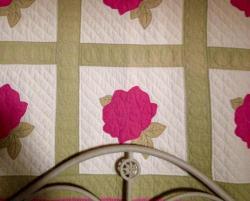
The Rose of Sharon is such a strong survivor. Hot sun, drought, low maintenance, harsh wind, and cold icy winters don't seem to bother it. Of course, living with such an identity problem and so much confusion surrounding its name, it has to be a very strong plant.
Sometimes people say, "Oh you were given the name of a person in the Bible." I just smile and say ''Yes.'' Sometimes they might mention I was named for a flower. I always want to ask which flower a rose or a tulip or a crocus, but I usually say "Yes" again. I don't tell them it's really the name of a couple of pieces of land mentioned in the Bible and not that of a person and maybe not even a specific plant. That might be too confusing.
Just as an extra point of interest, I received this note from our friend Zuzu: "I was born and raised in Korea, where
Hibiscus syriacus is the national flower, so I've always called it Mugunghwa."
Thanks Zuzu, now if I could only pronounce that word . . .

